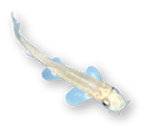The native Kangal fish in Central Asia and Turkey appears to be a natural phenomenon:
In the small city of Kangal in Turkey, located in the province of Sivas in south Anatolia,
the local population was the first to recognise the beneficial effect of the fish more than 200 years ago
when it came to various skin diseases.
The fish there live in thermal rivers and inshore waters at temperatures of up to 36° Celsius.
These inshore waters are very low in nutrients.
There are hardly any plants and other fish, as the temperatures are too high.
The people in this region have been using the warm thermal inshore waters for centuries for bathing
and curing rheumatic and other disorders.
In the course of time the fish have adapted to the presence of humans.
They have discovered human skin and danders as a rich source of protein and specialised in making use of them.
Humans have made use of the healing and beneficial combination of the fish and the pleasant temperatures and
enjoy this ingenious combination to this day.
This type of fish was mentioned for the first time in 1843 by a biologist by the name of Johann Jakob Heckel.
During its evolution the Garra Rufa has converted to protein foods and also lost all fear of humans.
It has no longer been possible to export the Garra Rufa from Turkey for many years.
In the meantime the fish are bred all over the world.
They are also used in particular by alternative practitioners for therapeutic purposes.
However, the fish are also in commercial use for wellness purposes and for carrying out cosmetic treatment,
e.g. in the so-called fish spas.
 The cosmetic fish pedicure using Kangal fish is still a trend that is becoming ever more popular in Europe
and also in Germany.
The cosmetic fish pedicure using Kangal fish is still a trend that is becoming ever more popular in Europe
and also in Germany.






